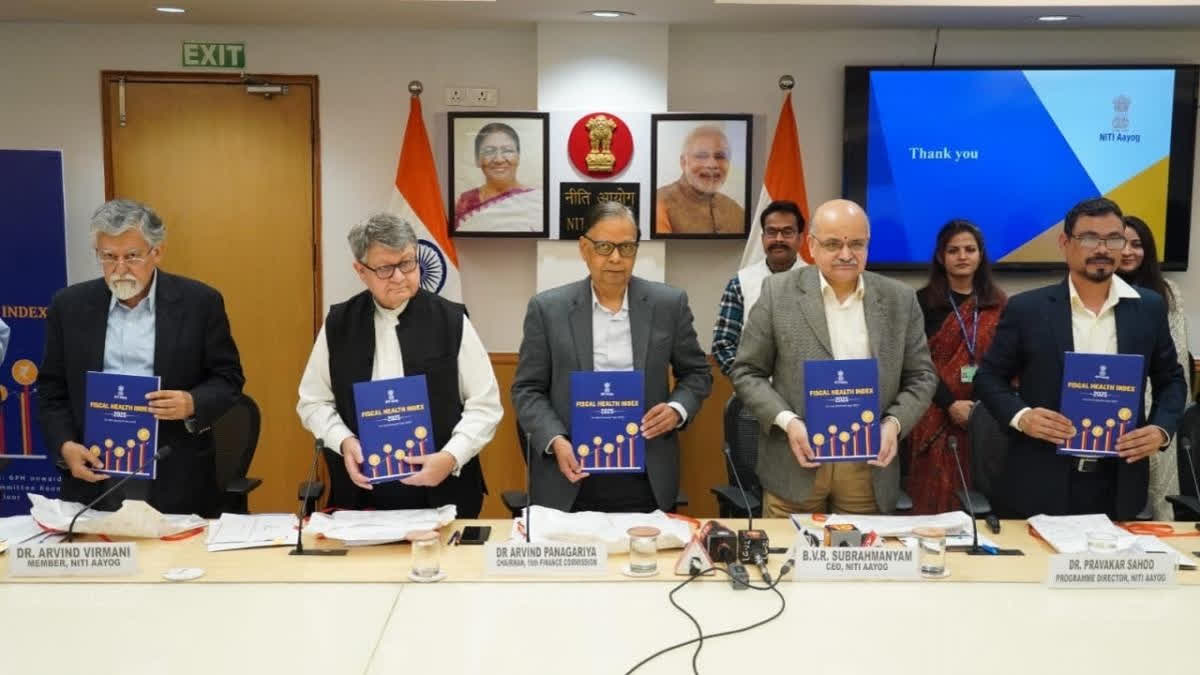By Surabhi Gupta
New Delhi: NITI Aayog on Friday unveiled its first Fiscal Health Index (FHI), a comprehensive report aimed at evaluating the financial stability of 18 major states.
Dr. Pravakar Sahoo, programme director, NITI Aayog told ETV Bharat, "The report examines fiscal health of the states in terms of five critical dimensions, expenditure quality, revenue mobilisation, fiscal prudence, debt index, and debt sustainability, providing insights into state-specific fiscal performance and its implications for long-term economic resilience."
The report excludes special category states and focuses on states contributing 85% of the cumulative gross domestic product (GDP) of India. The findings are based on data from the Comptroller and Auditor General (CAG) for the fiscal year 2022-23.
The Fiscal Health Index ranks states based on their performance across sub-indices, providing a holistic overview of their fiscal health. Odisha and Chhattisgarh emerged as India's fiscally healthiest states, while Andhra Pradesh, Punjab, West Bengal, and Kerala were categorised as "aspirational states", signalling the need for significant improvement.
Top Performers
Odisha secured the highest overall index score of 67.8, ranking first in the Debt Index (99.0) and Debt Sustainability (64.0). The state maintained low fiscal deficits, a healthy debt profile, and an above-average capital outlay-to-GSDP ratio. Chhattisgarh also performed well, particularly in revenue mobilisation due to its significant non-tax revenue collection from mining activities.
Lagging States
Punjab and West Bengal were flagged for their rising debt burdens. Interest payments in West Bengal constituted 20.47% of its revenue receipts in 2022-23, leaving little room for developmental expenditure. Kerala, grappling with high expenditures and limited revenue growth, was advised to focus on effective tax and non-tax strategies and rationalise expenditures to improve its fiscal health.
Breakdown of Critical Dimensions
1. Quality of Expenditure
The Quality of Expenditure index evaluates the ratio of developmental expenditure to a state’s total expenditure and the capital outlay-to-GSDP ratio. States like Uttar Pradesh and Bihar scored well in this dimension, while others lagged behind due to an overemphasis on non-productive revenue expenditure.
2. Revenue Mobilisation
Revenue mobilisation assesses a state's ability to generate resources through taxation and non-taxation avenues. States like Karnataka performed consistently well across indices, but weaker states, like Andhra Pradesh and Punjab, need to expand their revenue sources.
3. Debt Index and Debt Sustainability
The report highlighted growing concerns about debt sustainability. States like Punjab and West Bengal face increasing debt-to-GDP ratios, posing challenges to fiscal stability. "The growth rate of GSDP should ideally outpace the growth rate of interest payments for better debt sustainability," said Dr. Sahoo.
Recommendations for Improvement
The report doesn’t just rank states; it also provides state-specific recommendations. For states like West Bengal and Punjab, the focus should be on fiscal discipline and creating avenues for revenue growth. Kerala was advised to enhance capital expenditure in social services while optimising resource efficiency. Chhattisgarh, despite high revenue mobilisation, was encouraged to improve its debt sustainability.
Challenges for Aspirational States
Aspirational states, those at the bottom of the rankings, face structural fiscal challenges, including high debt levels and poor revenue mobilisation. "Some states are allocating more resources to popular social programs, reducing funds available for capital expenditure on productive infrastructure,” Dr. Sahoo noted.
The report also emphasised the need for benchmarking state performance to identify strengths and weaknesses. “This benchmarking exercise helps states understand where they stand and what corrective actions can be taken," Dr. Sahoo added.
Special Category States: A Different Framework
The report deliberately excluded special category states due to their distinct fiscal arrangements, which include higher central grants and different funding patterns for schemes. "These states receive 90% of their resources from the central government, making their fiscal profiles incomparable to the 18 states considered in the index," explained Dr. Sahoo.
Key Concerns and the Way Forward
One of the primary takeaways from the report is the declining quality of expenditure across many states. "Capital expenditure, which has a multiplier effect on economic growth, is falling in several states," the report observed. States must prioritise asset creation and infrastructure development to improve their long-term fiscal health, it said.
Dr. Sahoo also highlighted the alarming rise in debt ratios among some performer states, signalling a need for proactive fiscal management. "Rising debt levels give very little space for capital expenditure, which is essential for economic growth," he said.
Collaborative Efforts for Real-Time Data
To improve fiscal transparency, NITI Aayog plans to collaborate with the National Council of Applied Economic Research (NCAER) to develop a joint portal providing real-time state finance data. This dashboard aims to track revenue and expenditure patterns, enabling better policymaking.
The report noted that nearly 50% of countries are currently facing debt stress.



